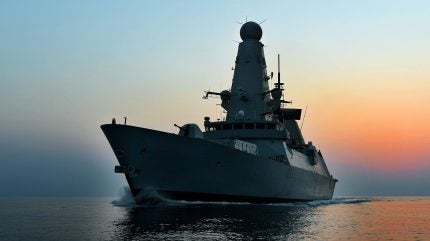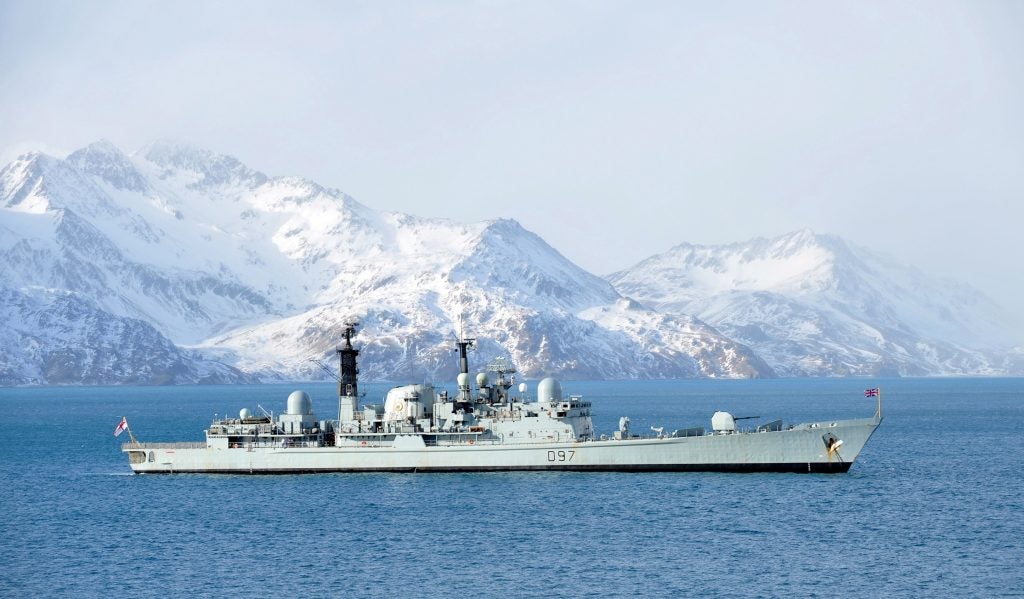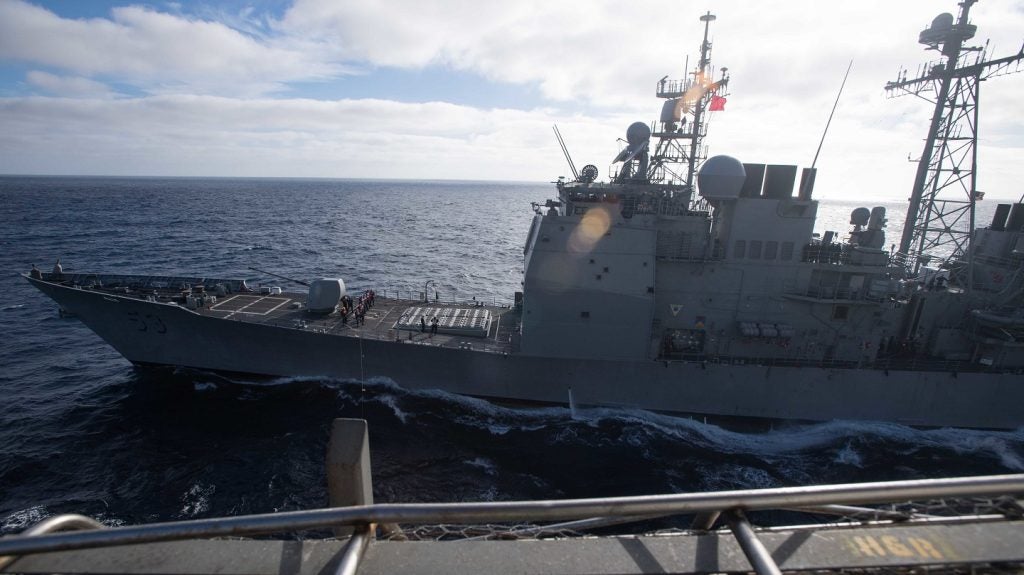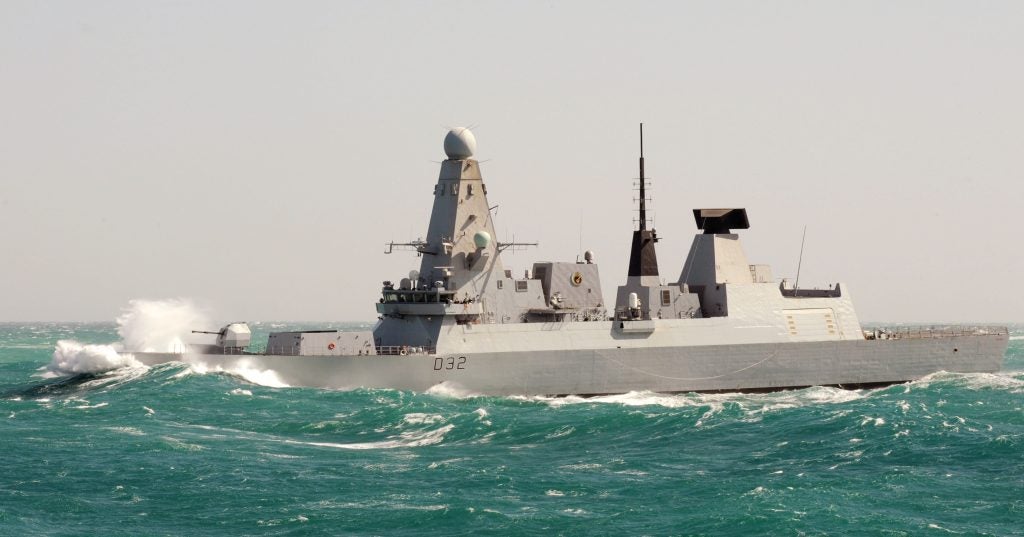
The UK’s planned Type 83 warship programme will develop a next-generation air defence platform for the Royal Navy, replacing the existing Type 45 class and introducing a range of new capabilities with a vessel likely to include ballistic and hypersonic missile defence and laser directed-energy (LDEW) weapons.
It will be at the heart of the Future Air Dominance System (FADS) programme, currently in its pre-concept phase, that will network a range of systems to create an air defence umbrella under which UK military can operate.
The previous UK Conservative government said earlier this year that the under current plans the first-of-class Type 83 air defence destroyer, which will replace the in-service Type 45 destroyer class (above), will enter service in the late 2030s.
The new Labour government has initiated a new Strategic Defence Review to determine whether any changes to the country’s defence modernisation programmes need to be made, but it is unlikely to derail the Type 83 programme.
How many Type 83 vessels will there be?
The UK has for decades replaced more numerous platforms with fewer, more capable systems, a process of ‘gold-plating’ that theoretically provides exquisite capability, but with virtually no strength in depth.
In the UK’s Defence in a Competitive Age document, published in March 2021, mentions of a Type 83 platform that would replace the Type 45 air defence destroyer proliferated under a ‘2030 vision’ that would have a “shipbuilding enterprise at the forefront of technological and environmental innovations”.
With the UK Ministry of Defence (MoD), or ‘Defence’ in the document, “committed to playing a leading role across government” in support of a national shipbuilding sector plan, programmes such as the nascent Type 83 would be particularly significant.
The document called for a “concept and assessment phase for our new Type 83 destroyer” which would begin to replace the 7,500 tonne-Type 45s from the late 2030s.
According to data from the previous UK government released in January 2024, the final Type 45 destroyer would leave service by the end of 2038, meaning the Royal Navy could see its air defence capability dwindle as earlier Type 45s are decommissioned ahead of the early-build Type 83s.

A total of six Type 45 destroyers were built, but this itself was reduced from 12 originally planned, with the class replacing the Falkland’s War era Type 42 destroyers (above), which numbered 14 hulls at full strength.
The Type 42s themselves were an attempt to produce an air defence-centric surface combatant, following the cancellation of the previous Type 82 programme, that saw just a single vessel (HMS Bristol) completed out of planned eight in class. The Type 82s were planned to replace the 1960s era County-class destroyers, designs which, while featuring missile-based anti-aircraft systems, stuck to multi-role roots with two, twin barrelled main guns mounted forward.
Keeping to the modern era, the Royal Navy has seen its air warfare destroyer force reduce, with the prospect that Type 83 fleet could dip further, perhaps to three or four hulls. However, in order to accommodate an expected wide range of weapons and required power generation, the Type 83 class could displace up to 10,000 tonnes each, perhaps reaching a length of 170-180 metres (m), compared to the Type 45 length of 152m.
What weapons could it feature?
A possible weapons outfitting for a future Type 83 destroyer is hypothetical at the pre-concept stage the programme is in, however it is possible to look at current and near future term capabilities that could be adopted to the class.
It is likely that the Type 83 will incorporate full length Mk 41 vertical launch systems (VLS) from the US, a capability being incorporated into the upcoming Type 31 and Type 26 frigates due to enter service this decade. The Mk 41 VLS is able to accommodate a range of short, medium, and long-range surface-to-air missiles, such as Raytheon’s SM-3 and SM-6.
The total number of Mk 41 launch cells that the Type 83 could feature is of course unknown, but in 2023 the Type 45 were confirmed to receive a planned 50% increase in missile capacity with the addition of a 24-cell Sea Ceptor farm, installed behind the 48-cell Sea Viper anti-air system. The Type 45 class use the French-origin A50 Sylver VLS, incorporating a mix of up to 48 short-range Aster 15 missiles for targets up to 30km away, and Aster 30 missiles for targets out to 120km.
The large Ticonderoga-class guided missile cruisers operated by the US Navy point to what kind of loadout a Type 83 of similar size could have, with the Tico’s featuring 122 Mk 41 launch cells.

In addition, Maritime Strike, or Block Vb, Tomahawk cruise missile will also be able to be fired from the Mk 41, providing a capable anti-surface warfare capability, or the joint UK-French Future Cruise Anti-Ship Warfare cruise missile, derived from MBDA’s Storm Shadow/SCALP system.
However, additional anti-surface munitions could be required, so it is likely that the Type 83 may also feature canister-launched missiles such as the Naval Strike Missile from Kongsberg.
It is almost certain that the Type 83 will also take advantage of directed energy weapons systems, such as the DragonFire high energy laser currently being developed by the UK, with trials of the platform expected to begin in the naval domain by 2027.

In terms of naval gunfire support, every main surface combatant of the Royal Navy has featured a main gun system, since the Ikara and Exocet variants of the Leander frigate in the 1960s. Given this, a main gun system such as the BAE Systems Mark 45, 5 inch 62-calibre weapons could be equipped.
Due to the increased threat of small and medium sized-drones and proliferation of anti-ship missiles into countries such as Yemen, it is also likely that the Type 83 will equip additional secondary weapons systems, including perhaps the 40mm Bofors being fitted to the Type 31 frigates, offering cost-effective target engagement.
The Type 83s will also certainly feature Phalanx CIWS, and numerous small arms from 7.62mm up to .50 calibre machine guns,
What sensors and propulsion could the Type 83 have?
Similar to determining any prospective weapons loadouts, pointing with complete certainty to sensor or propulsion equipment is still at best an estimation. However, a BAE Systems funded study, to be conducted by Reaction Engines, into exhaust heat reduction and capture possible suggests the future Type 83 could be a stealth design, or certainly incorporating increased stealth features.
The Type 83 will be conventionally propelled, with nuclear power being kept only for the Royal Navy hunter-killer and ballistic missile submarines. Rolls Royce’s MT30 gas turbines would be a strong option, coupled with MTU diesel engines, in a similar combined diesel-electric and gas (CODLAG) configuration being introduced into the Type 26 anti-submarine frigates.

Such propulsion may or may not be rafted in order to reduce acoustic noise, as the class will not be operated as anti-submarine warfare platforms, and likely used mainly in conjunction with the periodic Queen Elizabeth-class carrier strike groups, which feature a future full spectrum defence capability with the Type 26 and Type 31 frigates and Astute-class hunter-killers.
In order to generate as complete an air picture as possible, the main air search radars will be situated high up, likely in an integrated mast design, which have become increasingly common in modern warships.
This could also see the first use of a UK Aegis combat system from the United States, potentially with radar such as the AN/SPY-6(v) active electronically scanning array (AESA) radar, as being fitted to the US Navy’s Arleigh Burke Flight III destroyers.
Current and near future UK warships like the Type 45 and Type 26 operate the Type 1045/1046 and Type 997 Artisan tracking and surveillance radars respectively, with the Type 1045 and Type 1046 S&T radars of the Type 45s more in keeping with the likely mission of the future Type 83s.
Time is not to waste
With a prospective entry into service still around 14-15 years away, it could thought that the development of the Type 83 is not necessarily a pressing matter, with a decade-and-a-half to bring the pre-concept into reality.
However, consider the pace of UK shipbuilding in general, with the first-in-class Type 26 HMS Glasgow expected to take up to a decade from first steel cut to entry into service, and with the prospect that the Type 83 could be the most complex surface warship ever produced for the Royal Navy the need to turn towards fixing design elements becomes clear.
In addition, the abovementioned risk of Type 83 warships not replacing their Type 45 predecessors on a one-to-one basis as vessels are completed is a distinct possibility.




